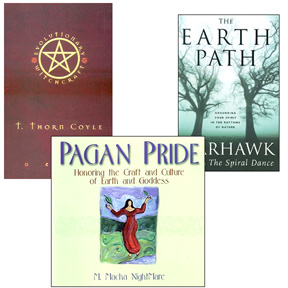
RQ Book Reviews
Want to submit a review? Email us!
Featured Reviews
in alphabetical order
reviews appear in reverse order, the most recent first
�
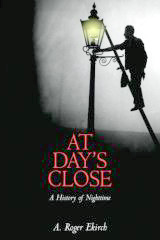
������������������������������������������������������������������������������������������������������������������������������������������������������������������������������������������������������������������������������������������������������������������������������������������������������������������������������������������������������������������������������������������������������������������������������������������������������������������������������������������������������������������������������At Day's Close
A History of Nighttime
by A. Roger Ekirch
Modern history has largely recorded only daytime events. What happened after nightfall is - or rather was until now - the forgotten half of human history.
Based on 20 years of research, At Day's Close: A History of Nighttime is reclaiming the night by painting a truly fascinating portrait of Western nocturnal life from the late medieval period to the Industrial revolution.
During this time - before the development and widespread use of artificial lighting - day and night were separated into much more contrasting worlds than today. Superstition, work, religion, and other factors were very different. At dusk, people entered "a shadowy realm filled with real and imagined perils" fearing "the evil aire of the night." They were plunged into mostly impenetrable darkness. Color and detail drained from the landscape and accidents were common. People fell into ditches, ponds, rivers, and off bridges. Horses unfamiliar with dark paths would throw their riders.
Widespread suspicion and fear of nighttime inspired by nature, superstition, death, evil spirits, wil-o'-the-wisps, ghosts, banshees, vampires, crime, drowning, fires, and other physical dangers plagued people at night in days of old far more than it does today. Ekirch illuminates the foundations of popular beliefs in "evil forces" and the occult. "Indeed darkness had become Satan's unholy realm on earth, a shadow government from which to wage perpetual warfare against the kingdom of Christ."
He also describes how the night literally provided a cloak of darkness for crimes and insurrections, and how fear of the night sometimes led to racist blame and accusation. There is a respectful and sobering mention of the witch hunt craze that engulfed societies, tearing pagan-folk apart, attributing it in part to the sweeping trends of the time including religious conflict, legal changes, the birth of printing, and rapid rate of societal change.
Moonlight was important for pre-industrial society. The monthly lunar cycle was a blessing. The nearly 12-hour light of the full moon was relied on heavily for travel and commerce "obliging me with as much light as was necessary to discover a thousand pleasing objects", noted a writer in 1712.
By the late 1660's, almanacs charting the moon's monthly progress represented the most popular publication after the bible in early America. Even the stars on unclouded nights were relied on.
Wrote the poet Robert Herrick:
Let not the dark thee cumber
What though the moon does slumber?
The stars of the night will lend thee their light.
Relationships and sexuality are discussed at length in the book. Prostitution was widespread and acts of nocturnal infidelity were a persistent source of literary humor.
Wrote the author of "Mistaking in the Darke" in 1620:
We have divers night men now a daies
That in the darke become such wilfull straies
When they should goe unto their wives chast bed
Doe get into the maids, in mistris stead.
Focusing on the cadences of daily life and primarily written from the perspective of the European continent (with some references to the early United States) the vocabulary and living habits of the past are brought back to life via quotes from and references to personal stories, memoirs, letters, poems, ballads, sermons, folklore, travel accounts, plays, coroner's reports, and court records.
Panoramic in scope, yet written intimately and filled with relevant, intriguing, and unusual illustrations that reveal a rich and complex universe, At Day's Close is an engrossing book with something fascinating on every page. Thanks to A. Roger Ekirch, the dark history of this mysterious time has now been told.
After reading this monumental work, you will never think of night the same way.
Reviewed by Randy Ralston
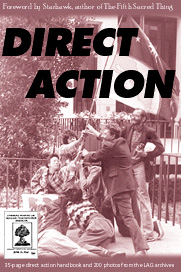
Direct Action
An Historical Novel by Luke Hauser
Reviewed by Starhawk
In Direct Action, Luke Hauser writes fiction so steeped in reality that he reproduces an era for us, with all of its excitement and frustrations.
Although the 1980s are generally thought of as a kind of dead zone for progressive activism, in the San Francisco Bay Area the early part of the decade was a time of fervent activism around nuclear issues.
Hauser's novel, set in that era, recreates the emotional and political milieu of the anti-nuclear blockades at Livermore Lab, Vandenberg Air Force Base, and the San Francisco Financial District. The nonviolent direct actions of the 70s and early 80s against nuclear power and nuclear weapons were the forerunners of a style of organizing that came to fruition in the blockade of the World Trade Organization in Seattle in '99. Many of the assumptions about nonhierachical organizations, the power of nonviolent direct action, and many of the tactics and strategies that inform the movement today were pioneered at that time.
Hauser was one of the organizers of the Livermore Action Group, which focused attention throughout the early eighties on Livermore Lab, run by the University of California - one of the two places in the U.S. where nuclear weapons were designed and developed. Livermore Action Group was born when organizing against nuclear power expanded to include nuclear weapons.
New Models of Protest
In the 1970s, as nuclear power plants began to be brought online, the dangers of nuclear power were becoming highly evident. The near melt-down at Three Mile Island in the Spring of '79 increased opposition.
On the East Coast, a group called the Clamshell Alliance pioneered a new mode of organizing in direct actions against the Seabrook Nuclear Plant at Seabrook, New Hampshire. Movement for a New Society, a Quaker-based social action group in Philadelphia, had conducted trainings in nonviolence and helped mold an organizing style. Instead of a central committee making decisions, the actions were organized by affinity groups, small groups of like-minded people that included both activists willing to risk arrest and those who would offer support. The affinity groups made decisions by consensus, and sent representatives to spokescouncils that made decisions for the whole action.
In California, Pacific Gas and Electric had begun building a nuclear plant on the ocean at a place called Diablo Canyon, just west of San Luis Obispo. Huge public opposition was aroused - especially when it came to light that the plant was being built over an earthquake fault. After a long campaign of legal challenges, the plant was finally ready to be licensed in the summer of 1981. As legal modes of opposition were exhausted, a group called the Abalone Alliance formed, modeled after the Clamshell Alliance. They held a huge rally in 1980, and a small blockade, but their major organizing effort went into a call for an emergency response, to blockade the plant and prevent the operators from loading the fuel rods, once the license for testing was granted,
The Diablo blockade took place in September 1981, and lasted about three weeks, during which over 5000 arrests were made. For everyone who took part, the blockade became a life-changing event. Three weeks of collective decision making and shared leadership gave us a strong sense of our own personal and collective power. Getting arrested, confronting authority, surviving custody, and often getting out of jail and returning to the blockade gave us ample opportunities to test our power, courage, and commitment, and come out stronger. While in jail, we used our time to hold workshops, talent shows, and meetings, and to discuss strategy. Reagan was pushing to build up our nuclear arsenal, characterizing the Soviet Union as the "Evil Empire," and talking about how to make nuclear war winnable. Nuclear war seemed a real possibility in the immediate future. Our new mode of organizing, combining direct democracy and nonviolent direct action, was so empowering and powerful that some of us decided we should expand and organize in a similar way against nuclear weapons.
Questions of Hierarchy
And so the Livermore Action Group was born. LAG, as it was familiarly called, organized its first blockade in February of 1982. It was followed by a larger blockade that June, on the Summer Solstice, billed as the International Day of Nuclear Disarmament. In these days of computers and the internet, when international organizing is easy and expected, it seems quaintly archaic to remember that we organized across borders by using regular mail and occasional long-distance phone calls. We had allies in the German anti-nuclear movement, and later developed allies even further afield, in Kazhakstan and Palau, wherever weapons had been tested and toxic residues left behind.
LAG soon acquired an office in Berkeley and a small paid staff-underpaid, but paid. There was always a tension in the organization between the paid staff and those who identified with the affinity groups, between a pull toward some centralization and core leadership, and an outward push into more direct democracy. The tension was mirrored by the emergence of a new group, the Vandenberg Action Coalition, which formed to oppose missile testing at Vandenberg, in Southern California.
The Vandenberg Action Coalition was more 'pure' in its devotion to nonhierarchical organizing, with no paid staff, no coordinating council, only representatives from affinity groups and working groups. LAG and VAC planned two actions in 1983 - a fixed-date action in January, noteworthy because almost all of us contracted dysentery from the camp food, and a floating date action that was planned to interfere with the actual testing of the MX.
Arrest at a military base meant Federal, rather than state, charges. After the January action, everybody was "banned and barred" from coming back to the base, but most were not charged. Repeat trespassers, however, faced greater risks in the Spring action. We planned a jail solidarity strategy - that we all would stay in jail to keep pressure on the authorities to drop or reduce charges, or at least to insure that second-timers were not treated more harshly. Part of that strategy was to withold names, to keep them from simply releasing some protesters and singling out others.
Hauser's novel traces the tensions and conflicts, and also the creative interactions, between the groups and the different approaches to organizing. He recreates the feelings, the issues, the controversies, with great fidelity. The novel goes through arrest and jail, and the central part of the narrative takes place during the extended jail stay after the June of '83 blockade. LAG had also planned for a jail solidarity strategy, which proved vitally important when the courts attempted to give us all (in addition to jail-time) a long period of probation, which would have prevented us from civil disobedience for months or years,
We ended up staying in jail for nearly two weeks, until the authorities gave in and dropped the idea of probation. Hauser does an excellent job of recreating the experience, the frustration, the waiting, the high points of mutual support and solidarity and the low points of depression in our unexpectedly long sojourn in custody. He brought back the experience so vividly that I could smell the unwashed bodies, feel the cold and the rough wool of the blankets, and taste once again that inimitable combination of spam and fruit cocktail the guards called "The Empire Strikes Back!"
The book continues through the following Summer, with a series of San Francisco protests at the 1984 Democratic Convention that were direct precursors of today's urban protest movement. The story ends with the dissolution of LAG, but stirs embers of hope among the ashes.
Anyone interested in the history of social movements or the antecedents of the global justice movement kicked off by Seattle will find this book fascinating. Hauser tells a good story, and creates characters that live and breathe. But he does more - he brings alive a part of our history that might otherwise be forgotten, and offers its lessons and legacy to the present.
Reviewed by Starhawk
Lots of historical photographs, book-excerpts, and reviews are online at DirectAction.org
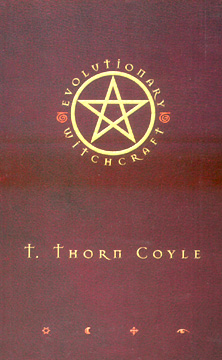
Evolutionary Witchcraft
By T. Thorn Coyle
Witch, peaceful activist, international teacher, dancer, musician with two albums of her own songs, Thorn Coyle has now penned Evolutionary Witchcraft.
While in process of publication, I asked Thorn what she was going to name her first book. When she told me, my heart stopped in joy.
Evolutionary - to evolve, to change from one level to another. The process of developing what is into what will be.
Through her 20 years of experience on the path, Thorn evolved from a young teenager exploring questions of why, and finding within herself the answers to spiritual and life directions.
Seeking knowledge and training under a Feri initiate who is also part of the Reclaiming tradition here in San Francisco, Thorn studied Sufi, worked in a Catholic soup kitchen where she applied the lessons in an everyday situation with the homeless, and closed the circle by studying with the late grand masters Victor Anderson and Cora Anderson.
Thorn not only was initiated in the Feri Tradition before Victor's departure from this Earth, but shares the black wand (highest level) with another initiate.
What is the Feri Tradition, and why is it spelled differently than "fairy?" Is this something new? Why is Feri different and yet the same and yet different?
Within the pages of this book you will discover the answers to these questions, and also understand why this book was written at this time.
This tradition has the same basics of any Earth-based religion, but there is a firm emphasis on the alignment of the practitioner's shadow and the growth of her/his power over time rather than on seasonal sabbats.
Instead of working with the basic four directions and the elements, the Feri practitioner works with seven directions/elements to complete a circle that is within and without.
The book features beautiful illustrations of dance movements/meditations that Thorn developed to correspond with the Iron Pentacle, Pearl Pentacle, and other tools of Feri.
Released with the blessing of Cora Anderson, this book makes the teachings of the Feri Tradition available to those souls who want to step into a new paradigm of Witchcraft.
Take a look at Thorn's website, www.thorncoyle.com, to discover how to expand your knowledge of the Feri Tradition.
Reviewed by Cerridwen.
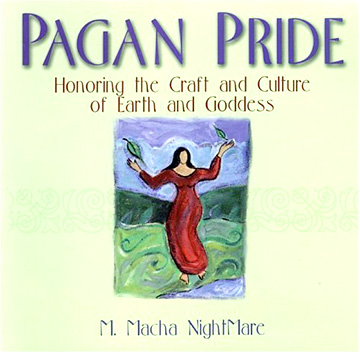
Pagan Pride
Honoring the Craft and Culture of Earth and Goddess
by M. Macha NightMare
In Pagan Pride, M. Macha NightMare has done an excellent job of describing the assorted accomplishments of Pagans and a generally Pagan world view. The book consists of a series of short essays about Pagan contributions to the history of human civilization. The essays are organized according to themes such as Art and Literature, Folklore and Folkways; Science and Technology; and Mythological Personages.
All of them are well-written and quite informative.
Even though nobody could pick up this book and-after turning a few pages-practice Neo-Pagan trads, they could easily tell whether a Neo-Pagan world view suited them.
That's why I think that it should be included in the list of ten required introductory books about Neo-Paganism. I even posted this opinion of mine on a thread in a Neo-Pagan forum, when a new seeker asked about resource books.
In fact, this thread made me wonder just how dusty and moth-eaten lots of Neo-Pagan advice about starting this path is. Yes, we do have good, reliable resources that have proven themselves over time. But some of the older sources are less and less representative of Neo-Paganism as it has grown and changed.
We need to use the good new resources, rooted in our own experience, brilliant with our own insights, and connected to the Deities and Guardians in today's circumstances (not those of the 50s-80s) to guide new seekers.
And, maybe, to extend our own habit-fettered selves. Macha's book is one of these resources. I give it five Pentacles.
Visit www.machanightmare.com. This review first appeared Au Sable, a Craft-themed webzine, http://ausable.crimsonzine.com
Reviewed by The Pitch Black Witch.
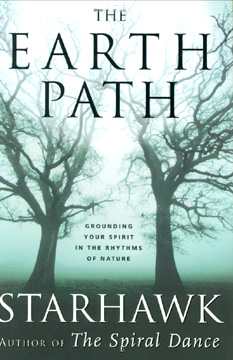
The Earth Path
Grounding Your Spirit in the Rhythms of Nature
by Starhawk
In between her writing ventures, I forget why and how much I admire Starhawk's work. Then her next book or essay is released, and I am reminded all over again of the reasons her philosophy grounds me in the profoundly sane dream of a better future.
Her most recent book, The Earth Path: Grounding Your Spirit in the Rhythms of Nature, serves as a guide to developing awareness of the most basic (and, as such, perhaps most elusive) elements of the natural world. Retreating somewhat from the frenetic pace of the streets in Webs of Power: Notes from the Global Uprising, The Earth Path takes us to Starhawk's home in the Cazadero Hills and through a journey of observing earth, air, fire, water, and spirit - the elements that sustain all life.
The opening chapter uses the fairy tale of the Isle of Birds to illustrate the author's desired outcome for this journey. In the story, a king sends his beloved son to learn the language of birds. After twenty-one years, the prince learns to hear, to understand, and to respond. For some inexplicable reason, this angers the king (perhaps he expected his son to learn marksmanship?), but the moral of the tale (and subsequently the entire book) is the importance of deep awareness and the simple fact that such awareness requires time and attention.
Readers who have followed Starhawk since 1979, when she published her best-known work, The Spiral Dance, will delight in watching her evolve in her spirituality and its application. The Earth Path will not disappoint her fans and students. It remains as accessible and unpretentious as her previous writing, with the honesty and emotional vulnerability that has always left her readers feeling we know her. Of course, it also includes the insightful, ironic, and sometimes piercing wit for which she is known and loved. Don't pick up a Starhawk book if you expect to come away smugly comforted in your personal righteousness!
One key to expanding the imagination, according to Starhawk, is ceasing to care what others think, creating a space with the freedom to think about anything at all. As Pagans, we are in a privileged position to do this since we already exist on the fringes of the "respectable" institutions of Western society, such as academia.
I found myself both disagreeing and feeling challenged by this idea. On one hand, many Pagans have worked hard to bring earth-based religion under the umbrella of "respectability" - establishing Pagan traditions as legally-recognized churches, securing seats on various ecumenical councils, organizing Pagans in military and police ranks, educating the courts, employers, and general public as to the relatively "normal" lives of most Pagans, right down to changing the dictionary definition of the word "Witch." Cultural behemoths, like academia, are, indeed, slow to change. But they do change, and I don't believe we're as far removed from academic respectability as Starhawk suggests, especially considering that many of today's Pagan leaders are highly educated. I see academia as similar to the places Starhawk talks about where two ecosystems meet and their diversity creates a mutual benefit and richness for both.
On the other hand, this question of respectability is a good reminder not to compromise what sets us apart from our predominantly alienating and exploitative culture. Religious movements tend to start out loosely organized, culturally marginalized, and socially radical. As they gain numbers, prominence, and respectability, a vicious circle of compromise to gain acceptance is set into motion (usually with a hard lurch to the political right; the Mormons are America's most recent example of this phenomenon). Starhawk's words challenge us not to compromise our values or who we are for public acceptance.
Overall, The Earth Path gives us a practical ethos of questioning how any given action will impact the whole, using deep attention to each element as a guide. Interwoven with this ethical paradigm are some treats new to Starhawk's readers. The text includes the clearest explanation of grounding and anchoring I've ever heard. The author's courage in defending meat-eating (is there a hotter topic anywhere in Pagandom?) is testament to her honest and principled character - the reader may not agree with her, but after taking such a risk, it's impossible not to trust her.
At times, the book's intended audience is a bit unclear. Much of the language and ideas seem aimed for the Pagan community. However, at other times, the text slips into explanations of the simplest Pagan history and theology - the basic explanation of the Sabbats is probably redundant for most readers. For anyone needing that basic information, the rest of the book will likely be confusing.
In the end, such minutiae is inconsequential. This is easily the best nonfiction I've read in 2004, and I encourage readers to find their favorite outdoor spot to curl up with The Earth Path and allow it to open their attention to the life cycle around us that is so important and so pervasive that it is too easily forgotten.
For those returning to Starhawk's work, The Earth Path will be a welcome addition to their collection. For those who have not yet had the pleasure, I encourage you to run, not walk, to introduce yourselves to the challenging work of one of the most important philosophers of our time.
Reviewed by Jennifer Martin-Romme.
Starhawk is an activist, organizer, and author of ten books, including The Spira Dance and The Fifth Sacred Thing. She teaches Earth Activist Trainings that combine permaculture design and activist skills, and works with the RANT trainer's collective, www.rantcollective.org. For teaching/travel schedule and other writings by Starhawk, visit www.starhawk.org
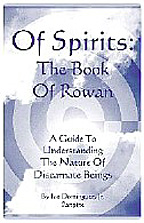
Of Spirits
by Ivo Dominguez Jr.
Anyone who has spent time in the Reclaiming tradition understands that we suffer from a lack of specificity in our language. Simply ask people what dropped and open means to them and you will find that there are at least three different schools of thought on the purpose and method of this technique.
The reason I bring this up is that Ivo Dominguez Jr. does a fantastic job of using precise language in describing the many forms of spirit contact, the mechanics of each type of communication, and giving tangible techniques for increasing one's capability to communicate with them. While this book is not intended as a workbook of techniques for increasing one's ability, the author explains that understanding the mechanism of each style of communication can increase one's ability to do so.
Dominguez, Jr. brings the best of the ceremonial and kabalistic traditions to his book. Of Spirits displays excellent scholarship not only from research but also from extensive personal practice. The book manages to describe different methods of communication, without telling the reader how their experience should be, and also avoids the trap of obfuscation that plagues the writing of so many ceremonial magicians.
As in his book Castings, Dominguez Jr. describes different categories of spirit contact, from ancestral to fey to deity. He specifies methods of increasing one's clarity of communication and the nature and limitation of communications with each. He does it in a grounded manner that leaves no doubt that this type of work is a lifetime endeavor. Though Dominguez Jr. does not describe himself as Reclaiming, he does a first-rate job describing his understanding of what is happening during aspecting, and challenges Reclaiming to better understand our own work.
Reviewed by Scott Mist
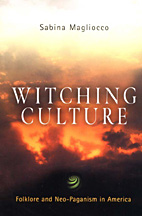
Witching Culture
Folklore and Neo-Paganism in America
by Sabina Magliocco
"Must Have, Double Bag!" is old school comic fandom's term for things that a fan cannot live without - and still have any fanboy or fangirl cred in the eyes of peers. And a perfect, to-the-point description of this book.
Sabina Magliocco, a Gardnerian and Reclaiming practitioner who also happens to be a skillful folklorist and anthropologist, is an associate professor at California State University, Northridge.
Witching Culture is thoughtful, insightful, fruitful, grounded, and - maybe - provocative. Witching Culture is well-crafted and a joy to read.
Witching Culture is one of the best ethnographies that I've read in a long time. Magliocco manages to accentuate the participation in her participant-observations, but sustain a vibrant and keen postmodern theoretical analysis at the same time. She takes the reader there to a living experience of an alternative culture.
She addresses a broad range of topics shaping and challenging Neo-Paganism, especially Craft i0n the San Francisco Bay Area, from how magic is envisioned as a working relationship with world and deities to ritual art and artistry to Neo-Pagan shopping habits to identity construction and cultural borrowing, and more. Like the Neo-Pagan bricoleurs she discusses, she takes advantage of theories and insights borrowed from a number of disciplines and discourses, putting the mix to good, understanding use.
Magliocco considers Neo-Pagan culture to be oppositional to dominant culture, postmodern in its world view at a time when the dominant modern culture offers little beyond materiality, consumerism, alienation, oppression, and spiritual- if not economic-impoverishment. She traces some roots of this oppositionality to sources in the Romantic and European nationalist movements, and provides a good account of Neo-Paganism's cultural creativity in shaping magical ritual, even political action.
Her approach to the creative and enculturating role that song plays in today's Neo-Paganism alone makes the book worthwhile.
Witching Culture is a "Must Have, Double Bag!" book that all of us should be proud to add to our libraries.
Note: I am Sabina's friend, and the "Pitch" in the book. All I can assure you is - as an old-school comic guy - if the book sucked, I'd say so. Far from it - Witching Culture shines bright!
Reviewed by The Pitch Black Witch.
Want to submit a review? Email us!
Like this feature? Please subscribe or donate today! - RQ needs your support to survive!
Return to RQ Home Page
|



